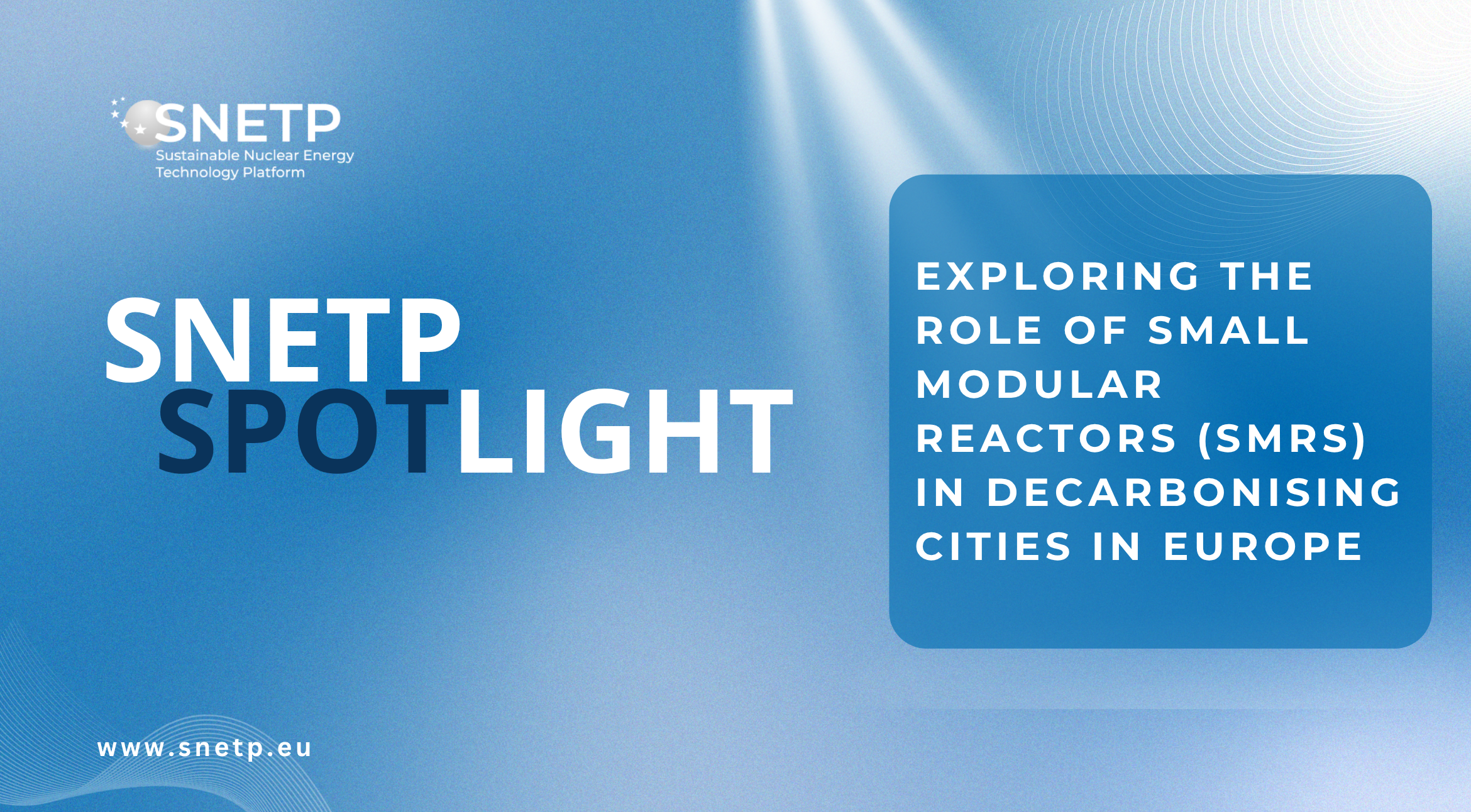As European cities work toward becoming climate-neutral under EU-funded initiatives like the NetZeroCities mission, innovative solutions are being explored to reduce emissions from urban energy systems. One promising approach is Small Modular Reactors (SMRs), which can supply both electricity and low-carbon heat for district heating networks and industrial processes, helping cities achieve their climate-neutral goals.
Last month, the SNETP (Sustainable Nuclear Energy Technology Platform) participated in an online webinar on SMRs for district heating, organised by NetZeroCities and hosted by Philippe Froissard, Head of Strategy, Policy Coordination and Urban Transitions at the European Commission’s DG Research & Innovation. The webinar brought together experts from the European Commission, the Joint Research Centre, and key Euratom-funded projects focusing on SMR technology to explore how nuclear innovation can support urban decarbonisation, complementing the EU’s broader climate-neutral urban transition agenda.
Speakers highlighted different aspects of SMR deployment. Domenico Rossetti di Valdalbero (DG RTD-Euratom Research) provided an overview of the EU agenda, initiatives, and regulatory frameworks for SMRs. Angelgiorgio Iorizzo (DG RTD) presented current and emerging SMR technologies, examples of ongoing projects, and the role of cities in leveraging innovation. The economic perspective was addressed by Angelgiorgio Iorizzo together with Michael Fuetterer (JRC), who discussed the SMR market, financing support, and models for local implementation.
Nuclear Applications for Heat and Industry: A Historical Perspective
Although most nuclear reactors have historically focused on electricity generation, there is a modest but meaningful track record of non-electric applications:
- District Heating: Around 43 reactors worldwide have supplied heat for district heating, representing ~500 reactor-years of experience. Typically, about 5% of a reactor’s thermal output is diverted to heating, with capacities from 5–240 MWth and temperatures below 150°C.
- Desalination: At least 17 reactors have been used for producing fresh water through thermal processes like multi-effect and multi-stage flash distillation.
- Industrial Process Heat: Selected reactors have provided heat to industrial facilities, such as salt refineries (Stade PWR, Germany), cardboard factories (Gösgen, Switzerland), fuel plants (Calder Hall, UK), and heavy water production (Bruce Power, Canada).
The figure below illustrates the geographical distribution of these past and existing demonstrations or commercial systems where nuclear heat has been applied to non-electric uses, highlighting the international experience in district heating, desalination, and industrial process heat.

Figure 1: Geographical distribution of past and current demonstrations or commercial systems using nuclear heat for non-electric applications.
Small Modular Reactors: Applications beyond electricity
SMRs are designed to be modular, factory-built and scalable, which makes them faster to deploy than conventional nuclear plants. One example is Last Energy, a company developing 20 MWe modular reactors that are built entirely in a factory and delivered as complete units. This approach is particularly relevant for district heating because it allows smaller nuclear units to be deployed close to cities or industrial areas, supplying both electricity and usable heat.
Last Energy’s approach is starting to attract interest in Europe. The Finnish energy company Helen is currently assessing potential sites for deploying such modular reactors as part of its strategy to decarbonise Helsinki’s heating system. Similarly, Calogena, a European district heating developer, is advancing low-carbon heating networks that could integrate nuclear-generated heat to replace fossil fuels. These examples illustrate how SMRs can become practical, near-term solutions for urban heat decarbonisation.
How European SMR Projects Support Heat and Industrial Decarbonisation
During the webinar on SMR technology for District Heating, three important Euratom-funded projects from SNETP’s Project Portfolio showcased their contributions to advancing the role of SMRs in sustainable energy systems:
- TANDEM Project: Hybrid Energy Systems and Hydrogen Production
Christophe Schneidesch (Tractebel) presented how the TANDEM Project explores the integration of SMRs into hybrid energy systems capable of producing electricity, heat, and hydrogen, enabling the decarbonisation of entire urban and industrial energy networks.
- EASI-SMR Project: Safety Innovations for European Deployment
Nicolas Sobecki (EFD) introduced the EASI-SMR Project, which develops safety frameworks and licensing innovations for Light-Water SMRs, paving the way for their use across Europe’s industrial and urban sectors, including hard-to-abate areas such as transport, chemicals, and steel.
- SANE Euratom Project: Non-Electric Applications of Nuclear Energy
Atte Helminen (VTT) shared insights from the SANE Project, assessing non-electric applications of nuclear energy, including district heating, desalination, and industrial process heat. The project builds on more than 750 reactor-years of global operational experience, as reported by the OECD Nuclear Energy Agency (NEA).
The webinar also emphasised the role of the EU SMR Industrial Alliance, presented by our General Secretariat representative, Abdou Al Mazouzi (EDF), highlighting opportunities for collaboration between nuclear innovators and European cities pursuing climate-neutral strategies.

